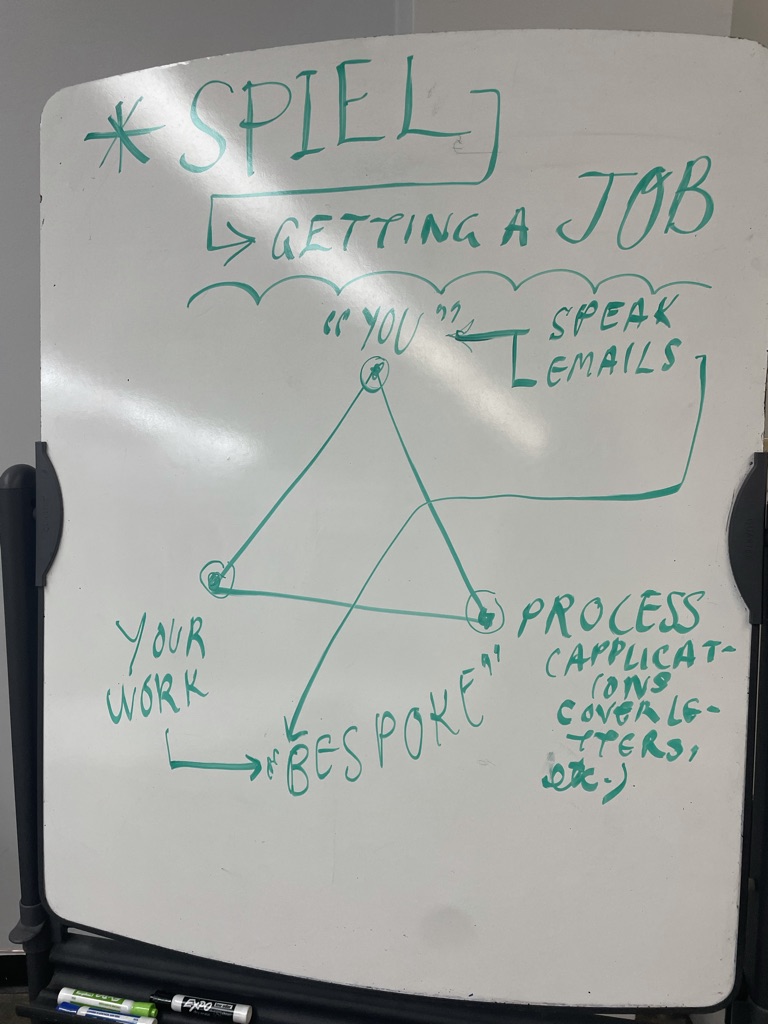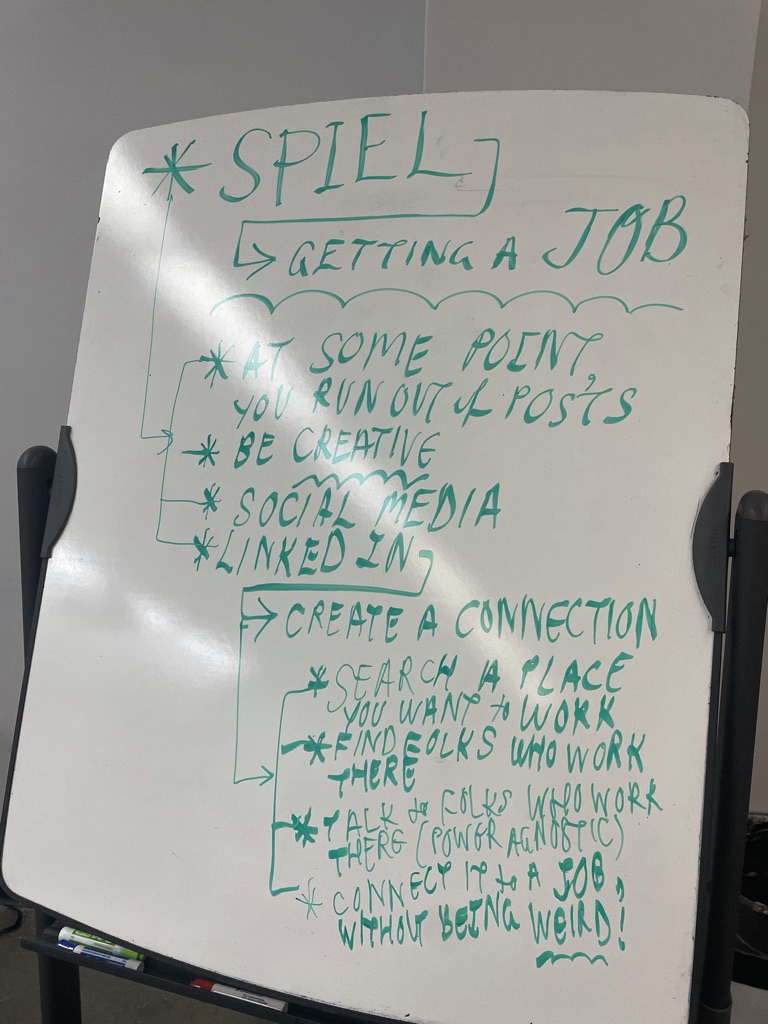Fall 2022 ︎︎︎ SUNY Purchase College ︎︎︎ (DES4100) Community Design
Spiel:
Getting a Job
Please note that these are recommendations to increase your shot at getting a job, it doesn’t guarantee anything.




Applying (slide 1)
- Realistically, you need to do “like...100 applications” which is to say, as literally as possible, you need to do as many applications as possible to increase your odds of landing an interview, becoming comfortable with interviews and then landing a job.
- The process of getting a job, is a job in itself. You should treat it like a part-time job and dedicate close to that amount of time to the process. I would recommend 4 hours a day if you can but of course your ability to do that may vary. You should be ready to apply this effort for several months if necessary.
- Be clear about the tasks you are trying to accomplish so that you don’t get lost in minutae.
- You should be looking for job posts, working on your portfolio, cover letters and the like.
The Process (slide 2)
The process you need to balance, as illustrated in slide 2 is:- “You” how you present yourself, how you speak, how you use language in emails, your Zoom background, etc.
-
The Process. Filling out applications, cover letters, finding job postings and industry-specific job boards.
-
Your Work. The things you have made, new things you make to supplement weak areas, and how you present this work online and through photography.
At times you will concentrate on one of these over the others but you need to keep these things balanced. I’d also keep in mind, that you want to prepare materials but also try to make sure your work and yourself are focused. So you might have a general cover letter but you want to have a custom version for each application or you might want to have specific portfolio sites for different types of work to prevent your main portfolio from appearing “all over the place”
Portfolios (slide 3)
-
Keep your portfolio simple. You want it to load fast and you want people to see images of your work as soon as possible.
-
Don’t code it. This is unless your work involves coding or you want to learn this skill specifically. Many portfolio services exist (Wix, Squarespace, Cargo, etc.) and their tools are robust and have portfolios in mind. This is also not to say learning to code is not worth it, but you want your website to be as easy to update as possible and prevent any instances where your site might break. Additionally, new technological paradigms will emerge and many of these websites will have the armature to respond quickly to these changes (responsive design, mobile design, etc.)
-
Keep your portfolio to 5 or 6 good pieces that are focused and related specifically to what you want to do.
- Make sure the photographs, mockups or imagery are high quality.
-
Make sure it works on mobile (see “don’t code”). People may be viewing your site on a phone or ipad. Make sure it is viewable there. Ask people you know to test a variety of devices.
- Specialize. Make sure there if you want to do brand design that your portfolio reflects this. If it does not; take projects you can modify and make them better, or create new projects to fill the holes in your portfolio.
Running Out of Posts (slide 4)
At some point you run out of job posts. You can search inDeed, LinkedIn, and any job boards specific to your field (motionographer for motion graphics for example) and if you are actually working on this with regularity you will run out of posts. You might also expand the kinds of jobs you are willing to reply to but eventually you’re applying for something that is totally unrelated to what you do. This is the point you must apply your creativity to the application process.Use social media, whatever you are comfortable with. Start conversations people, follow people you admire, and look for inspiration. Use this strategically as well. For example, whenever an illustrator (particularly editorial illustrators) posts their work on Instagram, they will usually tag an art director. Follow these people, and save them in a list of people to contact (tactfully) about jobs or send your work to.
Here’s one method to start up conversations:
- Go on a website like LinkedIn where people say where they work.
- Find a place that you’d like to work (go back to using other social media if you don’t have an idea for this part)
- Search for people that work at that place, their role doesn’t matter, but they should probably be involved in a creative aspect of the work (ie a designer, junior designer, or even production assistant would be fine here)
- Message these people (probably off LinkedIn). If they work somewhere you’d like to work their work is probably good, so it shouldn’t feel insincere to compliment them. Ask if any jobs are available, who to talk to about hiring, or if there are projects coming up where they might need to hire more folks. Try to do this naturally and do not be too transactional. That is to say talk, and don’t be too forward about your intention, but also don’t languish in not being clear about what you’re trying to achieve. It is a delicate balance, try to handle it sensitively.
Interviews (slide 5)
-
First, relax! If you got an interview, this is a sign the process is working. Use the interview as a learning opportunity and know that new skills you may need to develop might emerge.
-
Practice! The person hiring you knows they are hiring you not as a marketing person, but as someone who can execute design and have ideas and express them with clarity. You don’t need to be the most gregarious person but you must have some amount of confidence.
-
Be yourself++, that is to say, be true to yourself but maybe know you need to speak a bit louder, make better eye contact, sit up straighter. Know that you need to work on yourself but don’t treat it as a “problem”
-
Being nervous is fine, it means you care. If this is your first job a person interviewing you should understand that you are nervous about what it can mean for you. That being said, manage your nerves and know if you tap your fingers or feet or something like this.
-
Ask questions about why the position is open. If 5 people have quit in the past month, they may not be upfront about this, but you want to understand if the company is in some kind of transition. You also want to research the company on a website like glassdoor. Know that these can sometimes be hyperbolic like any aggregation of reviews, but you should be able to understand if there is a toxicity in the management, or an issue with the company causing people to quit or leave.